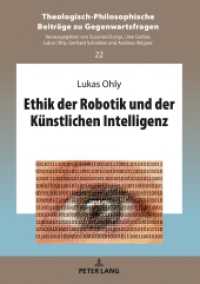- ホーム
- > 洋書
- > 英文書
- > Nature / Ecology
Full Description
This authoritative handbook surveys the full breadth and depth of SEA, bringing together a range of international perspectives and insights on the theoretical, methodological and institutional dimensions and practical issues of the field. It then subjects this conventional wisdom to a critical reappraisal, looks at the vast lessons of experience and offers new ideas and interpretations as to where the field is going.
The volume is organized into six major sections, beginning with an introduction and overview of the development of the field and a framework for evaluating SEA good practice. Part I comprises a review of SEA frameworks in leading countries (Australia, Canada, New Zealand and the USA), the European Union and developing regions (Africa, Asia, Latin America and Newly Independent States). Part II reviews SEA practice in several major sectors (energy, minerals, transport, water, development assistance and coastal zone management). Part III addresses the linkages between SEA and other comparable tools such as spatial planning and environmental management. Part IV probes key cross-cutting issues in SEA, including how to address cumulative and trans-boundary effects. Part V identifies ways and means of SEA process and capacity development, focusing on how to improve and upgrade the theory and practice of the field. Part VI examines the shift from conventional SEA towards more integrative approaches, drawing on experience and examples from a number of countries.
Published with IAIA
Contents
1. Introduction
Part I SEA Frameworks
2. SEA in Australia
3. SEA in Canada
4. SEA in New Zealand
5. SEA in the United States
6. SEA in the Asian Region
7. SEA in Eastern Europe, Caucasus and Central Asia
8. SEA in the European Union
9. SEA in Southern Africa
10. The SEA Protocol
Part II SEA Application
11. SEA and Transport Planning
12. SEA and Water Management
13. Regional Sectoral Assessment and Extractive Industries
14. SEA and Coastal Zone Management
Part III SEA Linkage to Other Instruments
15. Thematic Overview of Linkages Between SEA and Other Instruments
16. SEA and Environmental Planning and Management Tools
17. Landscape Planning
18. SEA as a Tool for Conservation and Sustainable use of Biodiversity in Developing Countries
19. Using SEA to Enhance Poverty Reduction Strategies
20. SEA and Spatial Planning
Part IV Cross Cutting Issues in SEA
21. Environmental Indicators in SEA
22. Some Wider Reflections on the Challenge of Public Participation in SEA
23. Addressing Health Impacts in SEA
24. Managing Cumulative Impacts: Making it Happen
25. Transboundary Issues in SEA
26. Planning in Tiers? Tiering as a Way of Linking SEA and EIA
Part V SEA Process Development and Capacity Building
27. SEA Process Development and Capacity-building - a Thematic Overview
28. SEA Theory and Research: an Analysis of the Discourse
29. Professional and Institutional Capacity Building for SEA
30. Developing SEA Guidance
31. Institutional Challenges for SEA Implementation and Decision Making: Search for Appropriate Organizations
32. From Formulation to Implementation: Strengthening SEA through Follow-up
33. SEA Knowledge and its use in Information Sharing, Training and Learning
Part VI: Toward Integrated, Sustainability Assessment
34. From SEA to Sustainability Assessment
35. Assessment for Sustainable Development








